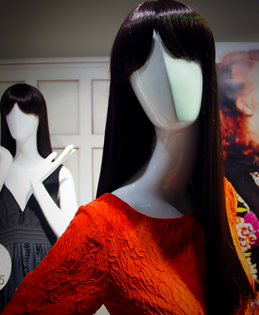
The mannequins in question are bigger and more plausibly shaped than those seen in UK shops. They are apparently a closer reflection of the average shopper than the usual 5'10 size 10 plastic fantastics in the window. While the 'real woman' mannequins photographed are more voluptuous they are also white, well proportioned and more toned than the average size 16 woman.
So can we argue that the moulds these mannequins are breaking truly reflect a Real Woman? Can many people honestly look at those mannequins and think 'that looks like me' and how often does a mannequin's physique sincerely register? I ask this because I would like to know what exactly we would like to push for with regard to capitalisms model of The Real Woman, which swings wildly between a hopelessly neurotic Bridget Jones stereotype and a well moisturised Dove model.
| Advertising and mannequin shape have clearly made womankind so anxious that the collective female digestive system has become dysfunctional and it now requires special yoghurt (while you're at it, you couldn't pop in some additional vitamin D there, just so the collective female skeleton doesn't crumble away – it just needs to keep it together in order to do the big shop). It also makes their heads feel they are full of sawdust, rather like a shop dummy, so they have to constantly pop painkillers or they won't be able to pick the kids up from school. | The Åhléns store has chosen not to request their mannequins share the average shoppers' protruding bellies, nor the big teen magazine dread 'one tit bigger than the other syndrome'. |
We do have the power to simply think 'meh', and 'meh' is actually pretty powerful. The year the maxi dress came back was the year the fashion rags told us hemlines were hitting the rafters and, as Patsy Stone would say, it was supposed to be the year the world would be our gynaecologist. The collective woman took a swig of Yakult and said 'Eff that when I have the option to grow my leg hair, forget tan anxiety and conceal cellulite, I'm buying one of those maxi dresses'.
There is also the joy in fashion that when a trend comes around that you hate you can take the attitude 'this too shall pass.' When, for some unfathomable (to me, to my personal aesthetic) reason, it was fashionable to make your hair asflat and lifeless as possible, some people went for it. Pub loos filled up with women at the mirror slicking their loose hair against their scalp and complaining about how massive their hair was. Some people didn't go for it. Now hair cannot be big enough. I am down with this back-combing trend and shall mourn it when it too passes.
So, while I am happy to applaud more diversity in models and mannequins let's not lose sight of the fact there's no law forcing you to conform. And that's because you actually are real and not a mannequin.
Squeamish Kate


 RSS Feed
RSS Feed
